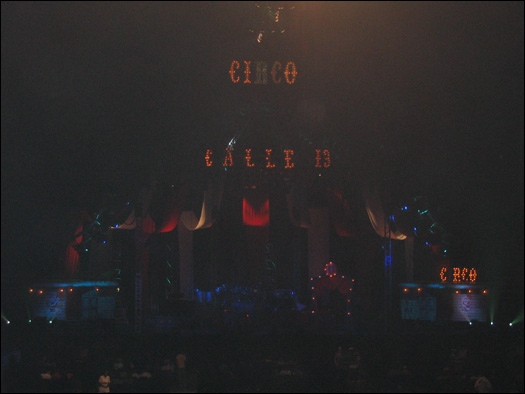

It has been hectic in Rotundolandia, what with the Calle 13 colosseum show, and numerous gallery, museum, and whatever you want to substitute for that hackneyed term “alternative space” doings. We were sweating chorros—or is that churros?—by the end of the week.
First things first: the Calle 13 show was, for us at any rate, quite the oddment but a deliriously good time. I’m not sure what we were expecting—I’ll admit that it’s been a few years since we saw a concert in a stadium or anything like it. I think the last sizable show was Milton Nacimiento at the old Hollywood Theater in Portland, Oregon, way back when, and what I remember, besides the lame dry-ice machine effects, is crazed Brazilians draped in enormous, very green national flags racing around and around the auditorium screaming at the tops of their lungs, “Mil-TON! Mil-TON! Mil-TON!” stopping only to jump up and down and grab each other and change direction. A friend of mine looked around in amazement and whispered, “Can’t you just imagine someone yelling, ‘Kill the Jews! Kill the Jews!’?” Well, Calle 13 was nothing like that, people actually listened to El Residente, El Visitante, and their hefty retinue of circus-themed bit players whoop it up with gymnastic Spanglish wordplay, largely extolling the virtues of sexual pleasure and disparaging consumerist excess, the FBI, and Pi Di Di. Those clowns and acrobats who were not wheeling about the stage on unicycles and giant gyroscope-like contraptions played real musical instruments which issued tuneful, highly danceable melodies. This is reggaetón?

As you know, we live in a time when any sort of likeness of the Prophet is forbidden, and with this in mind, we dwelt contentedly, pre-show, on the cheesy stage effects and the variety of footwear we observed in our vicinity rather than blasphemous—and, when it comes down to it, given all of the slavering press that Calle 13 has gotten lately, entirely redundant—shots of the splendidly muscled and coifed Residente, Puerto Rico’s thinking person’s rock god of the moment. Who, for all his agudez, can still write, “Yo soy caliente. Yo soy lava. Yo sooooooy la hormiga brava.”
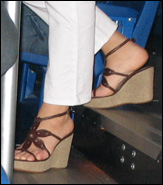
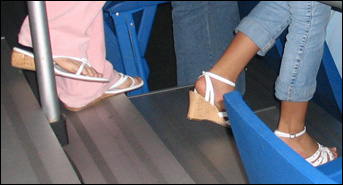
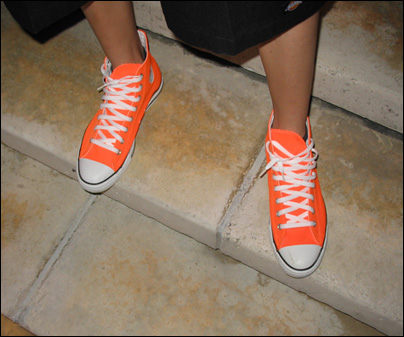
But let us step into the Wayback Machine for a few moments, and prepare ourselves for a kind of grandeur that never seems to vanish from the Puerto Rican scene but only spreads itself, like beach-glimpsed sun-toasted booty fed on years of fatty roasted pork, fried plantains, and generous helpings of Cool-Whip slathered flan de guayaba. Does this sound at all like artist Antonio Martorell? Not really. Antonio’s person is all mannerly elegance. He always cuts a svelte, well-turned-out figure, topped by one of the perhaps dozens of cool Panama hats he owns. Everyone knows this. His smiling graciousness is as persistent and inviting as the most cheerful of Los Tres Reyes Magos. Antonio has been with us, it seems, forever; a reigning eminence whose devotions to the image, the written word, and the peculiar crags, fissures, and warblings of Puerto Rican culture show up all over the place. This has made him, to his admitted satisfaction, a celebrity in certain circles; especially the ones a little closer to power and influence than makes the restless youth of the art world comfortable.
But no matter. Such are the rewards of stamina. And the rewards for Antonio this week have been especially abundant. For one thing, he got his own permanent suite at Viejo San Juan’s schmancy Hotel El Convento, alongside the likes of José Campeche and Francisco Oller. Each of these fundamentally Borinquen and classically-minded artists has a salón to his name, and Antonio decorated his three rooms and balconies in washes of word-infused reds, greens, and blues, framing a pantheon of nuns—las monjas letradas, he calls them—which the artist describes as “las religiosas emblemáticas de la fe y la literatura en lengua española.” Antonio did not simply embrace this project, he pounced upon it and swallowed it whole. Lighting fixtures, flower pots, etched-glass doors, table-cloths: every available surface and cranny was re-imagined as a vortex of language dedicated to exemplars of the one-time inhabitants of El Convento. Whatever you think of Antonio’s artistic trajectory, you cannot fault his enormous heart.
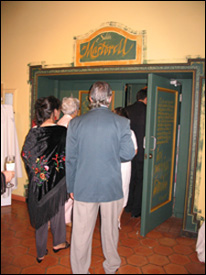
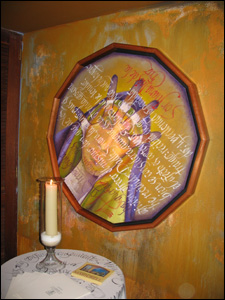
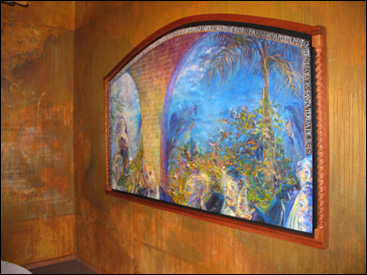
From top, clockwise: Entry to Salón Martorell during the opening ceremonies. “La mano de Sor Juana,” 2006, oil on linen, 50" diameter. “Las moradas,” 2006, oil on linen, 99.25" x 60.5", on painted walls with fragments of writing.
And speaking of that trajectory, among the portraits themselves are some marvels. I especially like “Santa Rosa de Lima y San Germán,” whose corner niche shows uncanny depths, and features one of the expertly turned frames that have distinguished Antonio’s paintings for years. If I was wearing one of those groovy Panamas, I'd doff it to the frame maker, Roberto Antonio Cortés.
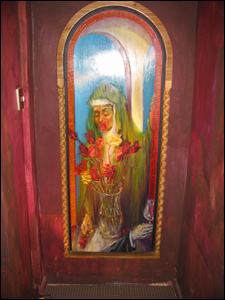
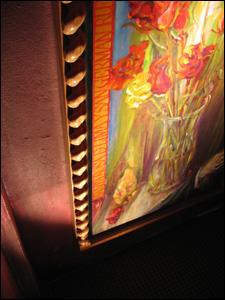
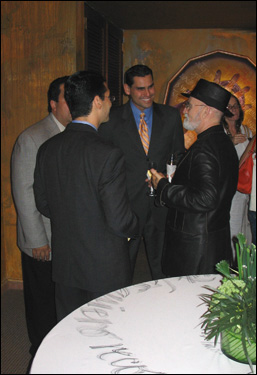
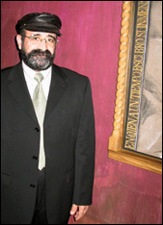
From top, clockwise: “Santa Rosa de Lima y San Germán,” 2006, oil on wood, 65" x 26". Detail of the frame. Frame-maker Roberto Antonio Cortés, standing beside his handiwork. El Maestro, being adored.
The overflow of this series of paintings ended up in the über-sniffy precincts of Galería Petrus, way across the tracks from El Convento geographically speaking, though nearby in spirit. Opening night was another opportunity for Antonio to show his painterly stuff and indulge his legions of admirers.
We’ll use the reverse thrusters of the Wayback to alight in Parque Luis Muñoz Rivera on the road to Viejo San Juan for one last art world juerga, an opening at the amazing little fortress-like structure there known as El Polverío. This colonial era powder-house, which is little more than a long, windowless tunnel vault sporting, out front, one of the island’s signature, absolutely fairy tale turrets, has been appropriated for a few weeks by six young San Juan area artists—and artist teams—for an exhibition of their paintings, sculptures, videos, installations, and otherwise unclassifiable whatnot.
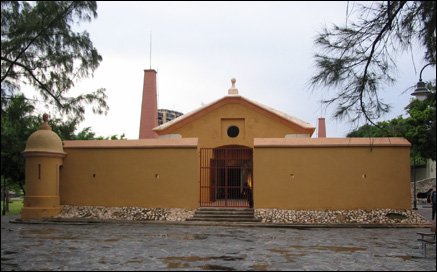
The work is generally well-put-together and fun, and certainly worth a look-see. My man Quintín Rivera Toro has a couple of paintings based on his schematic drawings of fave faux-violent movie tableaux, and Rogelio Báez Vega built a series of what look like bottled flying corkscrews. These faceted geometric riddles are somewhat reminiscent of NASA’s space program but may simply be playful formal exercises in a pseudo-scientific mode.
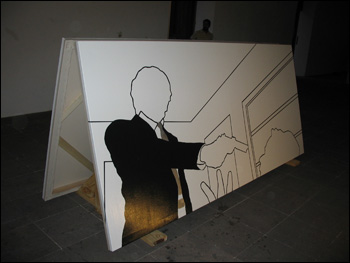
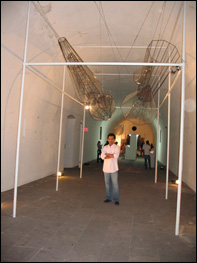
Left: “Pulp Fiction I,” 2006, acrylic on canvas, 9' x 4', by Quintín Rivera Toro. Right: “Varágine: Elogio de la Locura,” 2006, mixed media, variable dimensions, by Rogelio Báez Vega.
My personal fave, only because I have been a fanático of the funny papers ever since my aunt Estelle used the compound-word-limited discourses of Red Ryder and Little Beaver to teach me how to read, is a tall cabinet-like affair by the artists who prefer to be known only as W&N. (It may seem like a cool idea, folks, but tell us your names if you hope to have a career.) On one side of the cabinet is a shelf with several scalloped bowls filled with butter. White, white, white. But what does it mean? The thrilling part, at least for my inner four-year-old, is the grid of little paintings on the other side which features a veritable army of pop-culture icons, from The Hulk to Mr. Everywhere, Jesus H. Christ, including, as you’ll see below, Gumby, Condorito, and Sylvester Pussycat. Way to go, W&N!
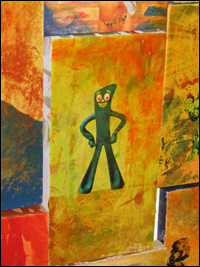
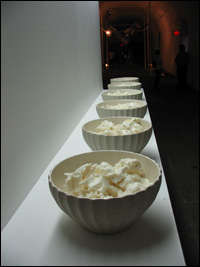
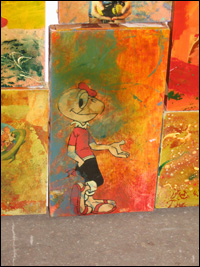
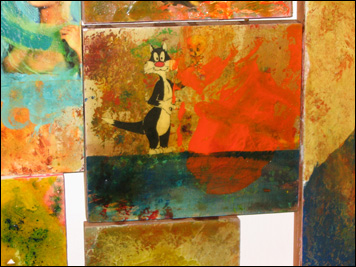
Above: details, front and back, from “Juegos,” 2006, mixed media, variable dimensions, by W&N.
“Polverío Colectivo” will run through June 2 at El Polverío in Parque Luis Muñoz Rivera. There are various events during with the show, such as a guided tour in conjunction with CIRCA on May 27, 2006. Contact and other information about the exhibition, including a list of the artists and a calendar, are available at the web site www.geocities.com/elpolverio.
